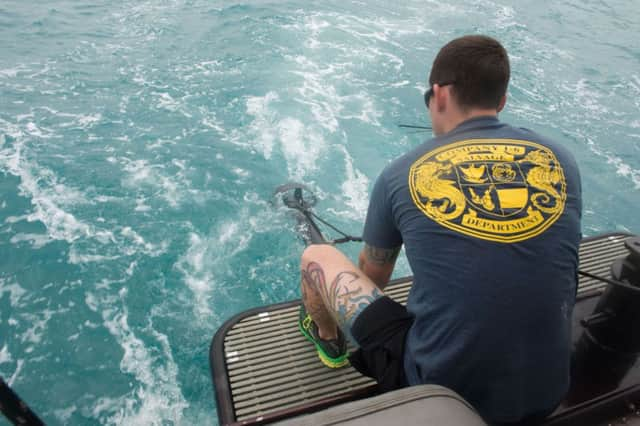Hopes of finding AirAsia jet’s black boxes rise


The jet’s black boxes are located in that part of the aircraft. If retrieved, they will give investigators vital clues to the reasons behind the plane’s plunge.
Powerful currents and murky water continue to hinder the operation, but searchers managed to get a photograph of the debris – around six miles from where Flight 8501 lost contact on 28 December – after it was detected by an Indonesian survey ship, national search and rescue chief Henry Bambang Soelistyo said.
Advertisement
Hide AdAdvertisement
Hide AdOne released image appeared to show an upside down “A” painted on a piece of metal, while another grainy shot depicted some mechanical parts.
“Today we successfully discovered the part of the plane that became the main aim since yesterday,” Mr Soelistyo said. “I can ensure that this is part of the tail with the AirAsia mark on it.”
Tony Fernendes, AirAsia’s chief executive, welcomed the news. If it is the right part of the tail section, he tweeted, then the cockpit voice and flight data recorders, or black boxes, “should be there”. The airline’s priority, he added, remains recovering all the bodies “to ease the pain of our families”.
The carrier, meanwhile, said families of those killed would be compensated in accordance with Indonesian laws. Each will receive $100,000, AirAsia Indonesia president Sunu Widyatmoko said.
Another find yesterday brought the number of bodies recovered to 40, but time is running out. At two weeks, most corpses will sink, said Anton Castilani, head of Indonesia’s disaster identification victim unit, and there are already signs of serious decomposition.
Officials are hopeful many of the 122 or so bodies still unaccounted for will be found inside the fuselage, which is believed to be lying near the tail.
The Airbus A320 went down halfway through a two-hour flight between Indonesia’s second-largest city of Surabaya and Singapore, killing everyone on board. It is not clear what caused the crash, but bad weather is believed to be a factor.
Just before losing contact, the pilot told air traffic control he was approaching threatening clouds, but was denied permission to climb to a higher altitude because of heavy air traffic. No distress signal was issued.
Advertisement
Hide AdAdvertisement
Hide AdFinding the black boxes will be key to the investigation. They provide essential information about the plane along with final conversations between the captain and co-pilot. The ping-emitting beacons still have about 20 days before their batteries go dead, but high waves had prevented the deployment of ships that drag “ping” locators.
Sonar-equipped ships involved in the massive international hunt have identified what they believe to be the fuselage of the plane in recent days. Five other big objects have been found on the floor of the ocean, though no visual confirmation has been obtained yet. Smaller pieces of the plane, such as seats and an emergency door, have been collected from the surface.
The search area for bodies and debris was expanded this week to allow for the strong currents that have been pushing debris around, said Indonesian search and rescue operation co-ordinator Tatang Zainudin.
The water in the Java Sea is relatively shallow at about 100 feet deep, but this is the worst time of year for a recovery operation because of monsoon rains and wind that create choppy seas.